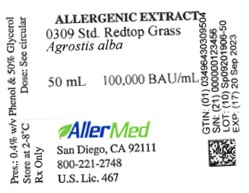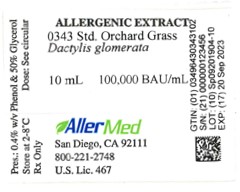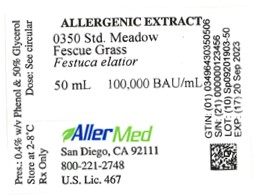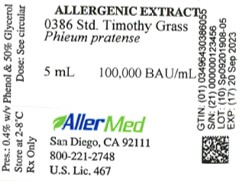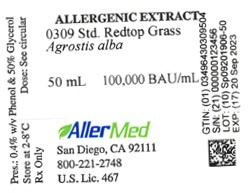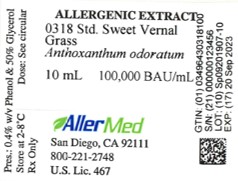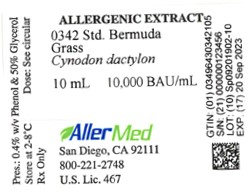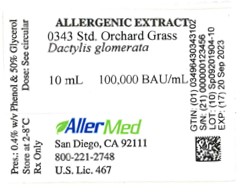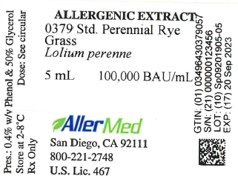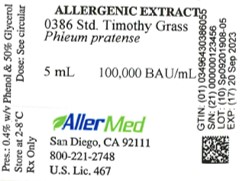Label: STANDARDIZED BERMUDA GRASS- cynodon dactylon injection
STANDARDIZED MEADOW FESCUE GRASS- festuca elatior injection
STANDARDIZED ORCHARD GRASS- dactylis glomerata injection
STANDARDIZED PERENNIAL RYE GRASS- lolium perenne injection
STANDARDIZED KENTUCKY BLUE (JUNE) GRASS- poa pratensis injection
STANDARDIZED REDTOP GRASS- agrostis alba injection
STANDARDIZED SWEET VERNAL GRASS- anthoxanthum odoratum injection
STANDARDIZED TIMOTHY GRASS- phleum pratense injection
-
Contains inactivated NDC Code(s)
NDC Code(s): 49643-309-05, 49643-309-10, 49643-309-30, 49643-309-50, view more49643-318-05, 49643-318-10, 49643-318-30, 49643-318-50, 49643-342-05, 49643-342-10, 49643-342-30, 49643-342-50, 49643-343-05, 49643-343-10, 49643-343-30, 49643-343-50, 49643-350-05, 49643-350-10, 49643-350-30, 49643-350-50, 49643-379-05, 49643-379-10, 49643-379-30, 49643-379-50, 49643-386-05, 49643-386-10, 49643-386-30, 49643-386-50, 49643-393-05, 49643-393-10, 49643-393-30, 49643-393-50 - Packager: Allermed Laboratories, Inc.
- Category: HUMAN PRESCRIPTION DRUG LABEL
- DEA Schedule: None
- Marketing Status: Biologic Licensing Application
Drug Label Information
Updated September 25, 2019
If you are a consumer or patient please visit this version.
- Download DRUG LABEL INFO: PDF XML
- Official Label (Printer Friendly)
-
BOXED WARNING
(What is this?)
WARNINGS
This product is intended for use by physicians who are experienced in the administration of allergenic extract or for use under the guidance of an allergy specialist. In previously untreated patients, the initial dose must be based on skin testing as described in the dosage and administration section of this insert. Patients being switched from alum-adsorbed or other types of
precipitated extracts to this extract should be started as though they were coming under treatment for the first time. Patients should be instructed to recognize adverse reaction symptoms and cautioned to contact the physician's office if symptoms occur. As with all allergenic extracts, severe systemic reactions may occur and in certain individuals these reactions may be lifethreatening or cause death. Patients should be observed for at least 20 minutes following treatment. Emergency measures as well as personnel trained in their use should be immediately available in the event of a life-threatening reaction. Patients being switched to a new lot of extract from the same manufacturer should have the dose reduced 75 percent. For dose selection in switching patients from unstandardized to standardized extract, physicians may refer to Table 3 as a guide (see CLINICAL PHARMACOLOGY). Extracts labeled in BAU/mL are not directly interchangeable with any other grass pollen product.
Patients receiving beta-blocking drugs may be refractive to the usual dose of epinephrine, in the event that epinephrine is required to control an adverse allergic reaction to this product. Caution must be exercised in testing and treating patients with steroid-dependent or labile asthma. This product should never be injected intravenously. See also WARNINGS and ADVERSE REACTIONS below.
Serious adverse reactions to this product should be reported to MEDWATCH, Food and Drug Administration, 5600 Fishers Lane, Rockville, MD 20852-9782. Telephone: (800) 332-1088.
-
DESCRIPTION
Standardized grass pollen extract is a sterile solution containing the extractables of grass pollen in 0.25% sodium chloride, 0.125% sodium bicarbonate, 50% glycerol v/v and 0.4% phenol w/v. Standardized grass pollen extracts include Bermuda Grass ( Cynodon dactylon), June Grass ( Poa pratensis), Meadow Fescue Grass ( Festuca elatior), Orchard Grass ( Dactylis glomerata), Perennial Rye Grass ( Lolium perenne), Redtop Grass ( Agrostis alba), Sweet Vernal Grass ( Anthoxanthum odoratum) and Timothy Grass ( Phleum pratense).
The extract may be administered by the scratch, prick, puncture, or intradermal methods of skin testing for diagnostic purposes and subcutaneously for therapeutic purposes as directed under Dosage and Administration.
The potency of standardized grass pollen extracts is expressed in Bioequivalent Allergy Units per mL (BAU/mL) and is determined by an in vitro ELISA Competition Assay comparing the extract to a U.S. reference grass pollen extract available from the Center for Biologics Evaluation and Research (CBER), U.S. Food and Drug Administration. Bioequivalent Allergy Units per mL (BAU/mL) have been assigned to the reference extract based on quantitative skin testing (see CLINICAL PHARMACOLOGY). CBER reference extract labeled 100,000 BAU/mL can be diluted 1:5 million and yield a 50 mm sum of erythema diameter response intradermally in highly puncture reactive subjects. CBER reference extract labeled 10,000 BAU/mL can be diluted 1:500,000 for the same response. 12
Allermed's standardized grass pollen extracts labeled in BAU/mL are not interchangeable with alumprecipitated grass pollen extracts, grass pollen extracts labeled in AU/mL or non-standardized grass pollen extracts.
-
CLINICAL PHARMACOLOGY
It is estimated that grass pollen is responsible for 10 - 30% of all IgE-mediated allergies worldwide 1. Temperate grasses, including Dactylis glomerata (Orchard Grass), Lolium perenne (Rye Grass), Phleum pratense (Timothy Grass) and Poa pratensis (Blue Grass), have practically identical allergenic characteristics. Subtropical grasses, such as Cynodon dactylon (Bermuda Grass), are antigenically distinct from temperate grasses and should be regarded as separate allergenic sources. For effective testing and treatment with grass pollen extracts, the extracts must be properly selected to represent the allergenic enviornment of the allergic individual 1,2,3,4.
Grass pollen extract may have as many as 40 components, of which 5 - 10 may be allergenic. The most important allergens are classified into groups I - VI. Allergens in these groups account for 90 - 100% of the IgE binding prevalence in the serum of grass pollen allergenic patients 1,5.
The pharmacologic action of grass pollen extract used diagnostically is based on the liberation of histamine and other substances when allergens in the extract react with specific IgE antibody attached to mast cells. The release of pharmacologically active mediators from mast cell results in the wheal-flare reaction associated with a positive skin test 6,7.
The basis for the clinical improvement of allergic symptoms following immunotherapy with grass pollen extract is not clearly understood. Several immunologic changes have been demonstrated that might be responsible for the amelioration of allergenic symptoms. These changes include (a) increase in serum IgG antbodies, (b) blunting of the seasonal rise of IgE antibodies, (c) elevation of blocking IgA/IgG antibodies in secretions, (d) reduced basophil reactivity and sensitivity to allergens and (e) reduced in vitro lymphocyte responsiveness to allergens 8. There is evidence that symptoms are effectively altered only by the administration of the relevant allergen 9,10,11.
The results shown in Table 1 were observed with 10,000 BAU/mL reference extract administered to 15 highly sensitive grass allergic persons by the puncture method (data on file at FDA). The intradermal doses (BAU/mL) of grass pollen extracts required to elicit 50 mm sum of erythema are shown in Table 2 12.
Table 1. Puncture data (bifurcated needle) with 10,000 BAU/mL reference grass pollen extracts. P∑E (mm) * P∑W (mm)† Reference Pollen FDA lot N Mean Range Mean Range Bermuda E4-Ber 15 90.3 43-123 15.7 7-31 June E3-Jkb 15 77.3 47-107 15.9 6-28 Meadow Fescue E4-MF 15 81.1 57-115 11.9 7-22 Orchard E4-OR 15 84.3 57-111 14.1 9-19 Perennial Rye E10-Rye 15 92.3 73-135 17.5 6-36 Redtop E4-RE 15 77.1 42-98 14.1 8-19 Sweet Vernal E4-SV 15 81.2 28-123 15.7 8-30 Timothy E6-Ti 15 88.3 51-109 16.9 8-40 Note: Relative potency compared to the U.S. Reference with potency of 1.0. The U.S. Reference for Bermuda Grass is 10,000 BAU/mL (range:6,900 - 143,000 BAU/mL). The U.S Reference for other grasses are 100,000 BAU/mL (range: 69,000 - 143,000 BAU/mL).
-
INDICATIONS AND USAGE
Standardized grass pollen extract is indicated for use in the diagnosis of grass allergy in patients with a history of allergic symptoms that occur during grass pollination. Skin tests with standardized grass pollen extract should be done first by the puncture method using 10,000 BAU/mL extract. If these tests are negative, they may be repeated by the puncture method with 100,000 BAU/mL extract, or by the intradermal method using an appropriate dilution (see DOSAGE AND ADMINISTRATION). The extract also is indicated for use in the treatment of allergic symptoms by immunotherapy in patients with a history of grass pollen allergy and established sensitivity to grass pollen extract by skin testing. The availability of 10,000 and 100,000 BAU/mL extracts facilitates dose selection for safe switching to standardized grass pollen extracts. Previously untreated patients should be initially treated with appropriately diluted 10,000 BAU/mL. If tolerated, higher doses may be indicated. The use of grass pollen extract for the above purposes should be made only by physicians with special familiarity and knowledge of allergy as described in a standard allergy textbook 13.
Allermed's standardized grass pollen extracts labeled in BAU/mL are not interchangeable with alumprecipitated grass pollen extracts, grass pollen extracts labeled in AU/mL or non-standardized grass pollen extracts.
-
CONTRAINDICATIONS
Immunotherapy should not be started in patients until a specific diagnosis of Type I allergy to grass pollen has been made from the patient's allergy history and from a positive skin test to grass pollen extract. Other contraindications include:
EXTREME SENSITIVITY TO GRASS POLLEN: Patients who experience serious adverse reactions to grass pollen extract from skin testing and/or immunotherapy should not be given the product.
AUTOIMMUNE DISEASE: Individuals with autoimmune disease may be at risk, due to the possibility of routine immunizations exacerbating symptoms of the underlying disease.
MYOCARDIAL INFARCTION: Patients who have experienced a recent myocardial infarction may not be able to tolerate adverse reactions resulting from skin testing or immunotherapy. The benefit-torisk ratio must be carefully evaluated in these patients.
CHILDREN WITH NEPHROTIC SYNDROME: Children with nephrotic syndrome require careful consideration and probably should not receive immunotherapy, due to a variety of seemingly unrelated events that may cause an exacerbation of nephrotic disease.
BLEEDING DIATHESIS: Injections of grass pollen extract should not be administered in the presence of diseases characterized by a bleeding diathesis.
-
WARNINGS
Standardized grass pollen extract must be diluted prior to first use on a patient for immunotherapy or intradermal testing (see DOSAGE AND ADMINISTRATION). Grass pollen extract is manufactured to assure high potency and has the ability to cause serious local and systemic reactions, including death in sensitive patients 14. Patients should be informed of this risk and precautions should be discussed prior to initiating skin testing and immunotherapy (see PRECAUTIONS).
Grass pollen extract should be temporarily withheld from a patient if any of the following conditions exist: (a) severe symptoms of rhinitis and/or asthma; (b) infection or flu accompanied by fever; (c) exposure to excessive amounts of grass pollen allergen prior to a scheduled injection.
SWITCHING PATIENTS TO STANDARDIZED GRASS POLLEN EXTRACT: The same precautions that are recommended in switching from an old to a new lot of non-standardized grass pollen extract should be followed in switching from non-standardized to standardized grass pollen extract, i.e., the dose of the new lot of standardized grass pollen extract should be reduced 75% of the dose given from an old lot of non-standardized grass pollen extract. Under certain circumstances, it may be advisable to compare the relative potency of the standardized and non-standardized extract by side by side skin testing using comparable v/v dilutions of the concentrates.
When switching from alum precipitated grass pollen extract to standardized grass pollen extract, the patient should be managed as a new patient coming under treatment for the first time.
-
PRECAUTIONS
GENERAL: The risk of a severe allergic reaction usually can be reduced by eliciting the patient's allergy history and by percutaneous testing by the scratch, prick or puncture method. If a scratch, prick or puncture skin test is negative, it usually is safe to perform an intradermal test with a one thousand-fold dilution of the extract used for the percutaneous test. If there is a history of unusual sensitivity, it is advisable to use a weaker dilution of the extract for skin testing.
Systemic allergic reactions may occur as a result of immunotherapy. The risk can be reduced by adherence to a careful injection schedule, which starts with a low concentration of extract and is increased slowly. The physician must be prepared to treat anaphylaxis should it occur and have the necessary drugs and equipment on hand to treat serious adverse reactions. Extracts should not be administered by the patient or by other individuals who are not prepared to treat anaphylaxis, should it occur.
Extract must be injected subcutaneously during immunotherapy. It must not be given intravenously. A separate sterile tuberculin syringe graduated in 0.01 mL should be used for each injection.
INFORMATION FOR PATIENTS: Because most serious reactions occur within 20 minutes after the injection of allergenic extract the patient should remain under observation for this length of time. The patient also should be instructed to report any unusual reactions to the physician, such as swelling and/or tenderness at the injection site or rhinorrhea, sneezing, coughing, wheezing, shortness of breath, nausea, dizziness or faintness following the injection of extract.
CARCINOGENESIS, MUTAGENESIS, IMPAIRMENT OF FERTILITY: Long term studies in animals have not been conducted with standardized grass pollen extract to determine the potential for carcinogenicity, mutagenicity or impairment of fertility.
PREGNANCY CATEGORY C: Animal reproduction studies have not been conducted with standardized grass pollen extract. It is also not known whether standardized grass pollen extract can cause fetal harm when administered to a pregnant woman or can affect reproduction capacity. Caution should be exercised in testing or treating pregnant females, because a systemic reaction might conceivably cause uterine muscle contractions leading to abortion. Standardized grass pollen extract should be given to a pregnant woman only if clearly needed 15.
PEDIATRIC USE: The dose of allergenic extract recommended for children is the same as for adults. Allowances may be made in the injection of large doses of extract for treatment. In this case, it may be advisable to modify the dose and frequency of injections, so that the discomfort is minimized.
NURSING MOTHERS: It is not known whether standardized grass pollen extract is excreted in human milk. Because many drugs are excreted in human milk, caution should be exercised when allergenic extract is administered to a nursing woman.
DRUG INTERACTION: Antihistamines and hydroxyzine can inhibit the immediate skin test reaction. Patients being treated with delayed absorption antihistamine tablets should be free of such medication for 48 hours before testing. Non-sedating antihistamines, such as terfenadine and astemizole, may variably suppress the skin response for longer periods of time up to six weeks. Epinephrine injection inhibits the immediate skin test reaction for several hours. Beta-blocking drugs may make a patient refractory to the usual dose of epinephrine, in the event epinephrine is required to treat an adverse allergic reaction.
-
ADVERSE REACTIONS
Local reactions consisting of erythema, itching, swelling, tenderness and sometimes pain may occur at the injection site. These reactions may appear within a few minutes to hours and persist for several days. Local cold applications and oral Antihistamines may be effective treatment. For marked and prolonged local reactions, steroids may be helpful.
Adverse systemic reactions usually occur within minutes and consist primarily of allergic symptoms such as generalized skin erythema, urticaria, pruritus, angioedema, rhinitis, wheezing, laryngeal edema and hypotension. Less commonly, nausea, emesis, abdominal cramps, diarrhea and uterine contractions may occur. Severe reactions may cause shock and loss of consciousness and fatalities have occurred (14).
The treatment of systemic allergic reactions is somewhat dependent upon the symptom complex. Epinephrine hydrochloride 1:1,000 aqueous, in an adult dose of 0.3 - 0.5 mL (or 0.01 mL per kg. for children) administered subcutaneously in the opposite arm is the immediate treatment of choice. A tourniquet should be placed above the site of the injection if the injection was done on the extremities. Antihistamines may offer relief of recurrent urticaria, associated skin reactions and gastrointestinal symptoms. Persistent wheezing may necessitate intravenous aminophylline treatment in addition to inhaled bronchodilators. For profound shock and hypotension, intravenous fluids, vasopressors and oxygen also may be needed. Maintenance of an open airway is critical if upper airway obstruction is present. Corticosteroids may provide benefit if symptoms are prolonged or recurrent. Serious adverse reactions to this product should be reported to MEDWATCH, Food and Drug Administration, 5600 Fishers Lane, Rockville, MD 20852-9782. Telephone (800) 332-1088.
-
OVERDOSAGE
A strong local reaction to the injection of extract may be treated with oral antihistamines and the local application of a cold compress. The dosage must be reduced and additional extract must not be given until all evidence of the reaction has disappeared. A systemic reaction following the injection of extract must be treated immediately with Epinephrine hydrochloride 1:1,000 aqueous and other measures as appropriate (see ADVERSE REACTIONS, paragraph 3 above).
- HOW SUPPLIED
-
DOSAGE AND ADMINISTRATION
Parental drug products should be inspected visually for particulate matter and discoloration prior to adminitration, whenever solution and container permit. The product should be discarded if discoloration or particles are observed.
DIAGNOSTIC USE: Standardized grass pollen extract may be used to diagnose sensitivity to grass pollen by performing skin tests on persons with a history of grass pollen allergy. Due to the risk of adverse reactions occuting in highly sensitive persons, it is mandatory to initially test all patients percutaneously using the scratch, prick or puncture method. If a properly performed percutaneous test is negative, an intradermal test may be used with caution.
PUNCTURE TEST: The punture test should be performed first with 10,000 BAU/mL extract. Data for the puncture test using 10,000 BAU/mL extract are summarized in Table 1 under CLINICAL PHARMOCOLOGY. If the puncture test to 10,000 BAU/mL extract is negative, the test may be repeated using 100,000 BAU/mL extract. Appropriate positive and negative controls for skin test interpretation are necessary. Reactions are quarntified based on size of erythema and wheal in reaction to controls.
INTRADERMAL TEST: An intradermal test should only be performed after a puncture test has been properly administered with a negative result. It is usually safe to initiate intradermal testing with a 1:1,000 v/v diluton of the extract to which a negative puncture test was observed. For example, if a puncture test is done with 10,000 BAU/mL extract and is negative, the intradermal test may be performed with 0.05 mL of 10 BAU/mL extract. The dose may be increased to 0.05 mL of 100 BAU/mL extract if the intradermal test with 10 BAU/mL extract is negative.
THERAPEUTIC USE: The dosage of grass pollen extract administered by subcutaneous injection during immunotherapy is highly individualized and varies according to the patient. In patients who appear to be highly sensitive by history and skin test, the initial dose of the extract should be low, such as 0.1 mL of a 0.01 BAU/mL dilution. The amount of extract is increased at each injection, but not more than 50%-100% of the previous amount, and the next increment is governed by the response to the last injection. Local reactions that persist longer than 24 hours are undesirable and any systemic reaction is an indication that the dose should be reduced (at least 50%). The upper limits of dosage have not been established, but doses larger than 0.2 mL of concentrate containing 50% glycerol may be painful due to the glycerol in the extract. The potency of each standardized grass pollen in a final mixture should not exceed that obtained from using a 10,000 BAU/mL stock concentrate of each grass included in the mix. Concentrate containing 100,000 BAU/mL should be diluted to 10,000 BAU/mL extract before being used to prepare final mixtures, or alternatively, the volume of 100,000 BAU/mL extract added to the mixture should be reduced 10-fold.
The optimum interval between dosed of grass pollen extract has not been definitely established. However, as is customarily practiced, injections are given one or two times per week until the maintenance dose is reached. At this time, the injection interval may be increased to 2 weeks, then to 3 weeks and finally 4 weeks. If the patient does not return for 6 to 8 weeks after the last injection, the dose should be reduced to 50% of the last dose. If longer than 8 weeks, a dose reduction of one, two or three dilutions may be made, depending on the amount of time that has elapsed since the last injection. The dosage and the interval between injections may need to be modified according to the clinical response of the patient. When switching patients to fresh extract, the initial dose should be reduced 75% [one-quarter (25%) of the previous dose administered from the old lot of extract]. A period of three to five years of injection therapy constitutes an average course of treatment. Children and geriatric patients appear to tolerate injections of allergenic extract well, and no special recommendations need to be made for these groups (see PRECAUTIONS - PEDIATRIC USE).
PREPARING DILUTIONS: To prepare dilutions for intradermal skin tests and therapeutic use, the stock concentrate may be diluted as shown in Table 4. Vial #1 is made by adding 1.0 mL of the concentrate to 9.0 mL of sterile diluent. This process is repeated until the desired concentration is achieved. Each number of allergy units per mL in each dilution is shown in Table 4.
Table 4. Directions for diluting standardized grass pollen extract containing 10,000 BAU/mL* Extract mL Extract mL Diluent Dilution Strength Dilution Label 10,000 BAU/mL 1.0 9.0 1,000 BAU/mL A Dilution A 1.0 9.0 100 BAU/mL B Dilution B 1.0 9.0 10 BAU/mL C Dilution C 1.0 9.0 1.0 BAU/mL D Dilution D 1.0 9.0 0.1 BAU/mL E Dilution E 1.0 9.0 0.01 BAU/mL F *If 100,000 BAU/mL extract is used to prepare dilutions, the 100,000 BAU/mL extract should be diluted 1:10 v/v before the directions shown in the table are followed.
-
STORAGE
The expiration date of standardized grass pollen extract is listed on the container label. The extract should be stored at 2°C to 8°C, if possible, and kept in this temperature range during office use. Dilutions of the stock concentrate containing less than 50% glycerol are less stable. If loss of potency is suspected, such dilutions should be checked by skin testing with equal units of a freshly prepared dilution.
-
REFERENCES
- Bierman, C.W., Pearlman, D.S., Shapiro, G.G., Busse, W.W. Allergy, asthma and immunology from infancy to adulthood, Third Edition, p. 533, W.B. Saunders, Philadelphia, 1996.
- Martin, B.G., Mansfield, L.E., Nelson, H.S. Cross-allergenicity among the grasses, Ann. Allergy, 54: 99-104, 1985.
- Milner, F.H., Tees, E.C. Specific sensitivity to individual grass pollens in some hay fever patients, Clinical Allergy. 2:83, 1972.
- Frankland, A.W., Augustine, R. Grass pollen antigens effective in treatment, Clinical Science, 23:95, 1962.
- Matthiesen, F., Lowenstein, H. Group V allergens in grass pollens. II. Investigation of group V allergens in pollens from 10 grasses. Clin. Exp. Allergy, 21:309-320, 1991.
- Ting, S., Dunsky, E.H., Lavker, R.M., et al. Patterns of mast cell alterations and in vivo mediator release in human allergic skin reactions, J. Allergy Clin. Immunol, 66:417, 1980.
- Zweiman, B. Mediators of allergic inflammation in the skin. Clin. Allergy, 18:419, 1988.
- Creticos, P.S. Immunologic changes associated with immunotherapy, Immunol. Allergy Clin., North Am., 12:13-37, 1992.
- Lowell, F.C., Franklin, W. A double-blind study of the effectiveness and specificity of injectiontherapy in ragweed hayfever. N. England J. Med., 273:675-679, 1965.
- Norman, P.S., Lichtenstein, L.M. The clinical and immunologic specificity of immunotherapy, J. Allergy Clin. Immunol., 61:370-377, 1978.
- Reid, M.J., Moss, R.B., Yoa-Pi, H., et al. Seasonal asthma in northern California: Allergic causes and efficacy of immunotherapy, J. Allergy Clin. Immunol., 78:590-600, 1986.
- Turkeltaub, P.C. The allergy unit-clinical relevance: issues in allergen standardization. In: Lockey, R.F., S.C. Bukantz eds., Allergen Immunotherapy, Marcel Dekkar, New York, 171-190, 1991.
- Middleton, E. Jr., Reed, C.E., Ellis, F.E., et al. Allergy Principles and practice, Fourth Edition, Vol. I, 573-594, Vol. II 1489-1509, Mosby, St. Louis, 1993.
- Reid, M.J., Lockey, R.F., Turkeltaub, P.C., Platts-Mills, T.A.E. Survey of fatalities from skin testing and immunotherapy, J. Allergy Clin. Immunol., 92: 6-15, 1993.
- Metzger, W.J., Turner, E., Patterson, R. The safety of immunotherapy during pregnancy, J. Allergy Clin. Immunol., 61:268, 1978.
- INGREDIENTS AND APPEARANCE
-
INGREDIENTS AND APPEARANCE
STANDARDIZED BERMUDA GRASS
cynodon dactylon injectionProduct Information Product Type HUMAN PRESCRIPTION DRUG Item Code (Source) NDC:49643-342 Route of Administration CUTANEOUS, INTRADERMAL, SUBCUTANEOUS Active Ingredient/Active Moiety Ingredient Name Basis of Strength Strength CYNODON DACTYLON POLLEN (UNII: 175F461W10) (CYNODON DACTYLON POLLEN - UNII:175F461W10) CYNODON DACTYLON POLLEN 10000 [BAU] in 1 mL Inactive Ingredients Ingredient Name Strength SODIUM BICARBONATE (UNII: 8MDF5V39QO) 0.00125 g in 1 mL PHENOL (UNII: 339NCG44TV) 0.004 g in 1 mL WATER (UNII: 059QF0KO0R) GLYCERIN (UNII: PDC6A3C0OX) 0.53 mL in 1 mL SODIUM CHLORIDE (UNII: 451W47IQ8X) 0.0025 g in 1 mL Packaging # Item Code Package Description Marketing Start Date Marketing End Date 1 NDC:49643-342-05 5 mL in 1 VIAL, MULTI-DOSE; Type 0: Not a Combination Product 12/02/1996 2 NDC:49643-342-10 10 mL in 1 VIAL, MULTI-DOSE; Type 0: Not a Combination Product 12/02/1996 3 NDC:49643-342-30 30 mL in 1 VIAL, MULTI-DOSE; Type 0: Not a Combination Product 12/02/1996 4 NDC:49643-342-50 50 mL in 1 VIAL, MULTI-DOSE; Type 0: Not a Combination Product 12/02/1996 Marketing Information Marketing Category Application Number or Monograph Citation Marketing Start Date Marketing End Date BLA BLA102214 12/02/1996 STANDARDIZED MEADOW FESCUE GRASS
festuca elatior injectionProduct Information Product Type HUMAN PRESCRIPTION DRUG Item Code (Source) NDC:49643-350 Route of Administration CUTANEOUS, INTRADERMAL, SUBCUTANEOUS Active Ingredient/Active Moiety Ingredient Name Basis of Strength Strength FESTUCA PRATENSIS POLLEN (UNII: A0WFQ8P6N1) (FESTUCA PRATENSIS POLLEN - UNII:A0WFQ8P6N1) FESTUCA PRATENSIS POLLEN 100000 [BAU] in 1 mL Inactive Ingredients Ingredient Name Strength SODIUM BICARBONATE (UNII: 8MDF5V39QO) 0.00125 g in 1 mL PHENOL (UNII: 339NCG44TV) 0.004 g in 1 mL WATER (UNII: 059QF0KO0R) GLYCERIN (UNII: PDC6A3C0OX) 0.53 mL in 1 mL SODIUM CHLORIDE (UNII: 451W47IQ8X) 0.0025 g in 1 mL Packaging # Item Code Package Description Marketing Start Date Marketing End Date 1 NDC:49643-350-05 5 mL in 1 VIAL, MULTI-DOSE; Type 0: Not a Combination Product 12/02/1996 2 NDC:49643-350-10 10 mL in 1 VIAL, MULTI-DOSE; Type 0: Not a Combination Product 12/02/1996 3 NDC:49643-350-30 30 mL in 1 VIAL, MULTI-DOSE; Type 0: Not a Combination Product 12/02/1996 4 NDC:49643-350-50 50 mL in 1 VIAL, MULTI-DOSE; Type 0: Not a Combination Product 12/02/1996 Marketing Information Marketing Category Application Number or Monograph Citation Marketing Start Date Marketing End Date BLA BLA102216 12/02/1996 STANDARDIZED ORCHARD GRASS
dactylis glomerata injectionProduct Information Product Type HUMAN PRESCRIPTION DRUG Item Code (Source) NDC:49643-343 Route of Administration CUTANEOUS, INTRADERMAL, SUBCUTANEOUS Active Ingredient/Active Moiety Ingredient Name Basis of Strength Strength DACTYLIS GLOMERATA POLLEN (UNII: 83N78IDA7P) (DACTYLIS GLOMERATA POLLEN - UNII:83N78IDA7P) DACTYLIS GLOMERATA POLLEN 100000 [BAU] in 1 mL Inactive Ingredients Ingredient Name Strength SODIUM BICARBONATE (UNII: 8MDF5V39QO) 0.00125 g in 1 mL PHENOL (UNII: 339NCG44TV) 0.004 g in 1 mL WATER (UNII: 059QF0KO0R) GLYCERIN (UNII: PDC6A3C0OX) 0.53 mL in 1 mL SODIUM CHLORIDE (UNII: 451W47IQ8X) 0.0025 g in 1 mL Packaging # Item Code Package Description Marketing Start Date Marketing End Date 1 NDC:49643-343-05 5 mL in 1 VIAL, MULTI-DOSE; Type 0: Not a Combination Product 12/02/1996 2 NDC:49643-343-10 10 mL in 1 VIAL, MULTI-DOSE; Type 0: Not a Combination Product 12/02/1996 3 NDC:49643-343-30 30 mL in 1 VIAL, MULTI-DOSE; Type 0: Not a Combination Product 12/02/1996 4 NDC:49643-343-50 50 mL in 1 VIAL, MULTI-DOSE; Type 0: Not a Combination Product 12/02/1996 Marketing Information Marketing Category Application Number or Monograph Citation Marketing Start Date Marketing End Date BLA BLA102217 12/02/1996 STANDARDIZED PERENNIAL RYE GRASS
lolium perenne injectionProduct Information Product Type HUMAN PRESCRIPTION DRUG Item Code (Source) NDC:49643-379 Route of Administration CUTANEOUS, INTRADERMAL, SUBCUTANEOUS Active Ingredient/Active Moiety Ingredient Name Basis of Strength Strength LOLIUM PERENNE POLLEN (UNII: 4T81LB52R0) (LOLIUM PERENNE POLLEN - UNII:4T81LB52R0) LOLIUM PERENNE POLLEN 100000 [BAU] in 1 mL Inactive Ingredients Ingredient Name Strength SODIUM BICARBONATE (UNII: 8MDF5V39QO) 0.00125 g in 1 mL PHENOL (UNII: 339NCG44TV) 0.004 g in 1 mL WATER (UNII: 059QF0KO0R) GLYCERIN (UNII: PDC6A3C0OX) 0.53 mL in 1 mL SODIUM CHLORIDE (UNII: 451W47IQ8X) 0.0025 g in 1 mL Packaging # Item Code Package Description Marketing Start Date Marketing End Date 1 NDC:49643-379-05 5 mL in 1 VIAL, MULTI-DOSE; Type 0: Not a Combination Product 12/02/1996 2 NDC:49643-379-10 10 mL in 1 VIAL, MULTI-DOSE; Type 0: Not a Combination Product 12/02/1996 3 NDC:49643-379-30 30 mL in 1 VIAL, MULTI-DOSE; Type 0: Not a Combination Product 12/02/1996 4 NDC:49643-379-50 50 mL in 1 VIAL, MULTI-DOSE; Type 0: Not a Combination Product 12/02/1996 Marketing Information Marketing Category Application Number or Monograph Citation Marketing Start Date Marketing End Date BLA BLA102219 12/02/1996 STANDARDIZED KENTUCKY BLUE (JUNE) GRASS
poa pratensis injectionProduct Information Product Type HUMAN PRESCRIPTION DRUG Item Code (Source) NDC:49643-393 Route of Administration CUTANEOUS, INTRADERMAL, SUBCUTANEOUS Active Ingredient/Active Moiety Ingredient Name Basis of Strength Strength POA PRATENSIS POLLEN (UNII: SCB8J7LS3T) (POA PRATENSIS POLLEN - UNII:SCB8J7LS3T) POA PRATENSIS POLLEN 100000 [BAU] in 1 mL Inactive Ingredients Ingredient Name Strength SODIUM BICARBONATE (UNII: 8MDF5V39QO) 0.00125 g in 1 mL PHENOL (UNII: 339NCG44TV) 0.004 g in 1 mL WATER (UNII: 059QF0KO0R) GLYCERIN (UNII: PDC6A3C0OX) 0.53 mL in 1 mL SODIUM CHLORIDE (UNII: 451W47IQ8X) 0.0025 g in 1 mL Packaging # Item Code Package Description Marketing Start Date Marketing End Date 1 NDC:49643-393-05 5 mL in 1 VIAL, MULTI-DOSE; Type 0: Not a Combination Product 12/02/1996 2 NDC:49643-393-10 10 mL in 1 VIAL, MULTI-DOSE; Type 0: Not a Combination Product 12/02/1996 3 NDC:49643-393-30 30 mL in 1 VIAL, MULTI-DOSE; Type 0: Not a Combination Product 12/02/1996 4 NDC:49643-393-50 50 mL in 1 VIAL, MULTI-DOSE; Type 0: Not a Combination Product 12/02/1996 Marketing Information Marketing Category Application Number or Monograph Citation Marketing Start Date Marketing End Date BLA BLA102215 12/02/1996 STANDARDIZED REDTOP GRASS
agrostis alba injectionProduct Information Product Type HUMAN PRESCRIPTION DRUG Item Code (Source) NDC:49643-309 Route of Administration INTRADERMAL, CUTANEOUS, SUBCUTANEOUS Active Ingredient/Active Moiety Ingredient Name Basis of Strength Strength AGROSTIS GIGANTEA POLLEN (UNII: HU8V6E7HOA) (AGROSTIS GIGANTEA POLLEN - UNII:HU8V6E7HOA) AGROSTIS GIGANTEA POLLEN 100000 [BAU] in 1 mL Inactive Ingredients Ingredient Name Strength SODIUM BICARBONATE (UNII: 8MDF5V39QO) 0.00125 g in 1 mL PHENOL (UNII: 339NCG44TV) 0.004 g in 1 mL WATER (UNII: 059QF0KO0R) GLYCERIN (UNII: PDC6A3C0OX) 0.53 mL in 1 mL SODIUM CHLORIDE (UNII: 451W47IQ8X) 0.0025 g in 1 mL Packaging # Item Code Package Description Marketing Start Date Marketing End Date 1 NDC:49643-309-05 5 mL in 1 VIAL, MULTI-DOSE; Type 0: Not a Combination Product 12/02/1996 2 NDC:49643-309-10 10 mL in 1 VIAL, MULTI-DOSE; Type 0: Not a Combination Product 12/02/1996 3 NDC:49643-309-30 30 mL in 1 VIAL, MULTI-DOSE; Type 0: Not a Combination Product 12/02/1996 4 NDC:49643-309-50 50 mL in 1 VIAL, MULTI-DOSE; Type 0: Not a Combination Product 12/02/1996 Marketing Information Marketing Category Application Number or Monograph Citation Marketing Start Date Marketing End Date BLA BLA102218 12/02/1996 STANDARDIZED SWEET VERNAL GRASS
anthoxanthum odoratum injectionProduct Information Product Type HUMAN PRESCRIPTION DRUG Item Code (Source) NDC:49643-318 Route of Administration CUTANEOUS, INTRADERMAL, SUBCUTANEOUS Active Ingredient/Active Moiety Ingredient Name Basis of Strength Strength ANTHOXANTHUM ODORATUM POLLEN (UNII: 2KIK19R45Y) (ANTHOXANTHUM ODORATUM POLLEN - UNII:2KIK19R45Y) ANTHOXANTHUM ODORATUM POLLEN 100000 [BAU] in 1 mL Inactive Ingredients Ingredient Name Strength SODIUM BICARBONATE (UNII: 8MDF5V39QO) 0.00125 g in 1 mL PHENOL (UNII: 339NCG44TV) 0.004 g in 1 mL WATER (UNII: 059QF0KO0R) GLYCERIN (UNII: PDC6A3C0OX) 0.53 mL in 1 mL SODIUM CHLORIDE (UNII: 451W47IQ8X) 0.0025 g in 1 mL Packaging # Item Code Package Description Marketing Start Date Marketing End Date 1 NDC:49643-318-05 5 mL in 1 VIAL, MULTI-DOSE; Type 0: Not a Combination Product 12/02/1996 2 NDC:49643-318-10 10 mL in 1 VIAL, MULTI-DOSE; Type 0: Not a Combination Product 12/02/1996 3 NDC:49643-318-30 30 mL in 1 VIAL, MULTI-DOSE; Type 0: Not a Combination Product 12/02/1996 4 NDC:49643-318-50 50 mL in 1 VIAL, MULTI-DOSE; Type 0: Not a Combination Product 12/02/1996 Marketing Information Marketing Category Application Number or Monograph Citation Marketing Start Date Marketing End Date BLA BLA102220 12/02/1996 STANDARDIZED TIMOTHY GRASS
phleum pratense injectionProduct Information Product Type HUMAN PRESCRIPTION DRUG Item Code (Source) NDC:49643-386 Route of Administration CUTANEOUS, INTRADERMAL, SUBCUTANEOUS Active Ingredient/Active Moiety Ingredient Name Basis of Strength Strength PHLEUM PRATENSE POLLEN (UNII: 65M88RW2EG) (PHLEUM PRATENSE POLLEN - UNII:65M88RW2EG) PHLEUM PRATENSE POLLEN 100000 [BAU] in 1 mL Inactive Ingredients Ingredient Name Strength SODIUM BICARBONATE (UNII: 8MDF5V39QO) 0.00125 g in 1 mL PHENOL (UNII: 339NCG44TV) 0.004 g in 1 mL WATER (UNII: 059QF0KO0R) GLYCERIN (UNII: PDC6A3C0OX) 0.53 mL in 1 mL SODIUM CHLORIDE (UNII: 451W47IQ8X) 0.0025 g in 1 mL Packaging # Item Code Package Description Marketing Start Date Marketing End Date 1 NDC:49643-386-05 5 mL in 1 VIAL, MULTI-DOSE; Type 0: Not a Combination Product 12/02/1996 2 NDC:49643-386-10 10 mL in 1 VIAL, MULTI-DOSE; Type 0: Not a Combination Product 12/02/1996 3 NDC:49643-386-30 30 mL in 1 VIAL, MULTI-DOSE; Type 0: Not a Combination Product 12/02/1996 4 NDC:49643-386-50 50 mL in 1 VIAL, MULTI-DOSE; Type 0: Not a Combination Product 12/02/1996 Marketing Information Marketing Category Application Number or Monograph Citation Marketing Start Date Marketing End Date BLA BLA102221 12/02/1996 Labeler - Allermed Laboratories, Inc. (073364531) Establishment Name Address ID/FEI Business Operations Allermed Laboratories, Inc. 073364531 manufacture(49643-309, 49643-318, 49643-342, 49643-343, 49643-350, 49643-379, 49643-386, 49643-393)

